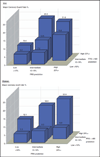Development and validation of an ankle brachial index risk model for the prediction of cardiovascular events
- PMID: 24367001
- PMCID: PMC4685459
- DOI: 10.1177/2047487313516564
Development and validation of an ankle brachial index risk model for the prediction of cardiovascular events
Abstract
Background: The ankle brachial index (ABI) is related to risk of cardiovascular events independent of the Framingham risk score (FRS). The aim of this study was to develop and evaluate a risk model for cardiovascular events incorporating the ABI and FRS.
Design: An analysis of participant data from 18 cohorts in which 24,375 men and 20,377 women free of coronary heart disease had ABI measured and were followed up for events.
Methods: Subjects were divided into a development and internal validation dataset and an external validation dataset. Two models, comprising FRS and FRS + ABI, were fitted for the primary outcome of major coronary events.
Results: In predicting events in the external validation dataset, C-index for the FRS was 0.672 (95% CI 0.599 to 0.737) in men and 0.578 (95% CI 0.492 to 0.661) in women. The FRS + ABI led to a small increase in C-index in men to 0.685 (95% CI 0.612 to 0.749) and large increase in women to 0.690 (95% CI 0.605 to 0.764) with net reclassification improvement (NRI) of 4.3% (95% CI 0.0 to 7.6%, p = 0.050) and 9.6% (95% CI 6.1 to 16.4%, p < 0.001), respectively. Restricting the FRS + ABI model to those with FRS intermediate 10-year risk of 10 to 19% resulted in higher NRI of 15.9% (95% CI 6.1 to 20.6%, p < 0.001) in men and 23.3% (95% CI 13.8 to 62.5%, p = 0.002) in women. However, incorporating ABI in an improved newly fitted risk factor model had a nonsignificant effect: NRI 2.0% (95% CI 2.3 to 4.2%, p = 0.567) in men and 1.1% (95% CI 1.9 to 4.0%, p = 0.483) in women.
Conclusions: An ABI risk model may improve prediction especially in individuals at intermediate risk and when performance of the base risk factor model is modest.
Keywords: Ankle brachial index; cardiovascular diseases; risk assessment.
Conflict of interest statement
The authors declare that there is no conflict of interest.
Figures

References
-
- Greenland P, Smith SC, Jr, Grundy SM. Improving coronary heart disease risk assessment in asymptomatic people: role of traditional risk factors and non-invasive cardiovascular tests. Circulation. 2001;104:1863–1867. - PubMed
-
- D’Agostino RB, Grundy S, Sullivan LM, et al. for the CHDRisk Prediction Group. Validation of the Framingham coronary heart disease prediction scores. Results of a multiple ethnic groups investigation. JAMA. 2001;286:180–187. - PubMed
Publication types
MeSH terms
Grants and funding
LinkOut - more resources
Full Text Sources
Other Literature Sources

